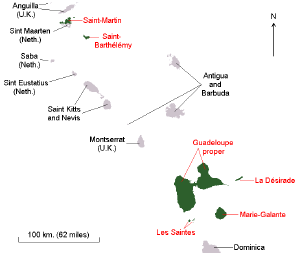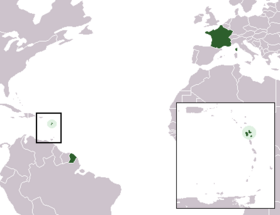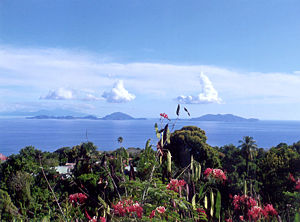Guadeloupe
| Région Guadeloupe | ||
|---|---|---|
|
Logo of Guadeloupe | |
| (Region flag) | (Region logo) | |
| Location | ||
| ||
| Administration | ||
| Capital | Basse-Terre | |
| Regional President | Victorin Lurel (PS) (since 2004) | |
| Departments | Guadeloupe | |
| Arrondissements | 2[1] | |
| Cantons | 40[1] | |
| Communes | 32[1] | |
| Statistics | ||
| Land area1 | 1,628 km²[1] | |
| Population | (Ranked 23rd) | |
| - January 1, 2006 est. | ca. 405,000[1] | |
| - March 8, 1999 census | 386,566[1] | |
| - Density (2006) | 249/km²[1] | |
| 1 French Land Register data, which exclude lakes, ponds, and glaciers larger than 1 km² (0.386 sq. mi. or 247 acres) as well as the estuaries of rivers | ||
Guadeloupe is an archipelago located in the eastern Caribbean Sea, with a land area of 1,628 square kilometres (629 sq. mi).[1] It is an overseas department of France. As with the other overseas departments, Guadeloupe is also one of the twenty-six regions of France (being an overseas region) and an integral part of the Republic. As part of France, Guadeloupe is part of the European Union; hence its currency is the euro.[2] Guadeloupe is however not party to the Schengen Agreement.
Geography
Guadeloupe is a group of islands of the Leenard group in the Eastern Caribbean Sea and comprises five islands: Basse-Terre, Grande-Terre, La Desirade, Les Saintes, and Marie-Galante. Further to the north, Saint-Barthélemy and the French part of Saint Martin once came under the jurisdiction of Guadeloupe but on December 7, 2003, both of these areas voted to become an overseas territorial collectivity. [1]
The neighbouring islands to Guadaluope are Antigua to the north, Montserrat to the west, and Dominica to the south.
Guadeloupe's political capital is Basse-Terre located in the southernwest coast of Basse-Terre Island. The largest urban town is Pointe-à-Pitre.

Topography
Gaudalupe's two largest islands, Basse-Terre and Grande-Terre, are similar to the shape of a butterfly and are separated by a mangrove channel called Salt River. Basse-Terre, the western island, is mountainous and has an active volcano called La Soufrière 4812 ft (1467 m) above the sea level. Grande-Terre, the eastern island, is mostly flat and is composed of limestone on its outer surface because the island was submerged under water in earlier geological periods. Marie-Galante and La Désirade are also limestone. They are flat dessert-like islands. Les Saintes is comprised of eight islands and only two are inhabited: Terre-de-Haut and Terre-de-Bas. Les Saintes' typical landscape is composed of volcanic hills and deep bays.
Climate
Guadeloupe's mean temperature at the flatter islands is 88 F(31 C); at the higher elevations it is 73 F(23 C). Basse-Terre Island is cooler and rainier than Grande-Terre. The winds which come from the northeast blow strongly over the flat plains of Grande-Terre (Grande means 'big' referring to the big winds and not to the big terrain) but are stopped by the mountains to the west in Basse-Terre (Basse means 'low' referring to the low winds that hit the island).
Fauna and Flora
Guadeloupe's vegetation is very diverse due to its topography. Basse-Terre is a contrast of mangrove swamps and forest trees, such as gums and chesnut trees. The forest has thick fern, flowering heliconia and ginger plants. The flatter islands are mostly dry and have a predominant presence of cactus. The main birds found in Guadeloupe are pelicans, hummingbirds, and the Guadeloupean wren. There are raccoons, mongooses, agoutis( looks a bit like a guinea pig), and iguanas.
History
Discovery and Settlement
Guadeloupe was discovered by Christopher Columbus on his second trip to the Americas in 1493. He called it Santa María de Guadalupe de Extremadura, after the image of the Virgin Mary venerated at the Spanish monastery of Villuercas, in Guadalupe, Extremadura. The Spanish made two attempts to settle Guadeloupe in the 1500s, but because of the fierceness of the Caribs the Spanish abandoned their claim of the islands.
After three decades, the French American Islands Company delegated Charles Lienard and Jean Duplessis, Lord of Ossonville, to colonize one or any of the region’s islands, Guadeloupe, Martinique or Dominica. Due to Martinique’s inhospitable nature, the duo resolved to settle in Guadeloupe. The French took possession of the island on June 28, 1635. They drove out many of the Carib amerindians, planted crops and built the first sugar mill. By this time, in 1674, Guadeloupe was annexed to the kingdom of France and a slave-based plantation was established.
First British Seizure
Over the next century, the island was seized several times by the British. For example, Guadeloupe was occupied by the British between 1759 and 1763 and during this time Pointe-a-Pitre was developed into a major harbor where the planters were allowed to export sugar and import North American lumber and food. Many French colonists actually grew wealthier under the British occupation and the economy expanded rapidly. Another indication of Guadeloupe's prosperity at this time was that in the Treaty of Paris (1763), France, defeated in war, agreed to forfeit its territorial claims in Canada in return for British recognition of French control of Guadeloupe[citation needed].
1789 French Revolution - Monarchists and Republicans
In 1790, the upper classes of Guadeloupe refused to obey the new laws requiring equal rights for the free colored and attempted to declare independence, resulting in great disturbances; a fire broke out in Pointe-à-Pitre and devastated a third of the town, and a struggle between the monarchists (who wanted independence) and the republicans (who were faithful to revolutionary France) ended in the victory of the monarchists, who declared independence in 1791, followed by the refusal to receive the new governor appointed by Paris in 1792.
Second British Seizure
In 1794, the British invaded Guadeloupe again and the French sent a contingent of soldiers guided by a Black nationalist Victor Hugues who freed and armed the Guadeloupean slaves. Eventually, the British withdrew but Victor Hugues took advantage of the situation and killed 300 royalists and plantation owners. Hugues became a terror to the French because he killed more than 1000 colonists and because the commercial interests in the USA were thretened. Thus,the USA declared war on France. At this point France sent General Richepance to Guadeloupe to restore the status quo. He succeeded inmediately and re-established slavery. Louis Delgrès and a group of revolutionary soldiers killed themselves on the slopes of the Matouba volcano when it became obvious that the invading troops would take control of the island. The occupation force killed approximately 10,000 Guadeloupeans in the process of restoring order to the island.
Third British Seizure
In 1810, the British once again seized the island and held it until 1816, when it was ceded to Sweden as a consequence of the Napoleonic Wars. Sweden already had a colony in the area, but only a year later Sweden left the island to France in the Treaty of Paris of 1814. An ensuing settlement between Sweden and the British gave rise to the Guadeloupe Fund. French control of Guadeloupe was finally acknowledged in the Treaty of Vienna in 1815.
Slavery Abolished
Slavery was abolished on the island in 1848 at the initiative of Victor Schoelcher. Today the population of Guadeloupe is mostly of African origin with an important European and Indian active population. Lebanese, Chinese, and people of many other origins are also present.
Politics
Template:Politics of Guadeloupe
Foreign Relations
Military
Administrative divisions
Administratively, Guadeloupe is divided into arrondissements, cantons and communes:
- Arrondissements of the Guadeloupe department
- Cantons of the Guadeloupe department
- Communes of the Guadeloupe department
Economy
The economy of Guadeloupe depends on tourism, agriculture, light industry and services. It also depends on France for large subsidies and imports.
Tourism is a key industry, with 83.3% of tourists visiting from metropolitan France, 10.8% coming from the rest of Europe, 3.4% coming from the United States, 1.5% coming from Canada, 0.4% coming from South America and 0.6% coming from the rest of the world.[3] An increasingly large number of cruise ships visit the islands.
The traditional sugarcane crop is slowly being replaced by other crops, such as bananas (which now supply about 50% of export earnings), eggplant, guinnep, noni, sapotilla, paroka, pikinga, giraumon squash, yam, gourd, plantain, christophine, monbin, prunecafé, cocoa, jackfruit, pomegranate, and many varieties of flowers. Other vegetables and root crops are cultivated for local consumption, although Guadeloupe is still dependent on imported food, mainly from France.
Light industry features sugar and rum, solar energy, and many industrial productions. Most manufactured goods and fuel are imported. Unemployment is especially high among the youth. Hurricanes periodically devastate the economy.
The country code top-level domain (ccTLD) for Guadeloupe is ".gp."
Demographics
(July 2006 estimates from the CIA World Factbook; note that these estimates disagree with official INSEE estimates and that they also include Saint-Martin and Saint-Barthélemy)
Culture
Guadeloupe's culture is probably best known for the islanders' literary achievements, particularly the poetry of Saint-John Perse, the pseudonym used by Alexis Léger. Perse won the 1960 Nobel Prize in Literature "for the soaring flight and the evocative images of his poetry which in a visionary fashion reflects the conditions of our time."
Guadeloupe has always had a rich literary production prolonged today by many living writers, poets, novelists, essayists and journalists, among them Maryse Condé, Ernest Pépin and Simone Schwartz-Bart.
Also culturally important are the arts, particularly painting and sculpture. Famous painters and/or sculptors include Michel Rovelas, Claudie Cancellier, Jean-Claude Echard, Christian Bracy, Roger Arekian, les Frères Baptiste, Michelle Chomereau-Lamothe, Léogane, Pédurand, Nicole Réache, Victor Sainsily. Photographer and visual effects artist Karim Sahai of Weta Digital, New-Zealand, has worked on the visual effects of The Lord of the Rings, King Kong, X-Men, etc.
Music and dance are also very popular, and the widely accepted interaction of African, French and Indian[4] cultures has given birth to some original new forms specific to the archipelago. Islanders enjoy many local dance styles including the quadrille "au commandement," zouk, zouk-love, toumbélé, as well as all the modern international dances. Typical Guadeloupean music includes la biguine and gwo ka à la base. Many international festivals take place in Guadeloupe, like the Creole Blues Festival, the Marie-Galante Festival, Festival Gwo-Ka Cotellon, etc. It goes without saying that all the Euro-French forms of art are also omnipresent in the melting pot.
Another element of the Guadeloupean culture is its dress. Women in particular have a unique style of traditional dresses, with many layers of colorful fabrics, now only worn on special occasions. On festive occasions they also wore a madras (originally the 'kerchief' from South India) head scarf tied in many different symbolic forms. The headdress could be done in many styles with names like the "bat" style, or the "firefighter" style, as well as the "Guadeloupean woman." Jewelry is also important, mainly of gold, in the Guadeloupean lady's dress, a product of European, African and Indian inspiration. Many famous couturiers like Devaed or Mondelo are Guadeloupeans.
Football (soccer) is popular in Guadeloupe. Thierry Henry, a star of the French National Team and Spanish League club FC Barcelona, often visits, as his father Antoine was originally from the island. Lilian Thuram, a star football defender for France and FC Barcelona, was born in Guadeloupe. The French national team and Manchester United striker, Louis Saha, is also of Guadeloupean descent as is Swansea City goalkeeper Willy Gueret. The region's football team also experienced recent success, advancing all the way to the 2007 CONCACAF Gold Cup semi-finals, where they were slightly defeated 1-0 by CONCACAF powerhouse, Mexico. Many valuable track and field athletes, such as Marie-José Perec, Patricia Girard-Léno and Christine Arron, are also Guadeloupe natives.
Notes
- ↑ 1.0 1.1 1.2 1.3 1.4 1.5 1.6 Figure without the territories of Saint-Martin and Saint-Barthélemy detached from Guadeloupe on February 22, 2007.
- ↑ Guadeloupe is pictured on all Euro banknotes, on the backside at the bottom of each note, right of the Greek ΕΥΡΩ (EURO) next to the denomiation.
- ↑ Guadeloupe - Economie (in FR) (1998). Retrieved 2006-06-10.
- ↑ Sahai, Sharad (1998).Guadeloupe Lights Up: French-lettered Indians in a remote corner of the Caribbean reclaim their Hindu identity. Hinduism Today, Digital Edition, February 1998.
External links
- Préfecture de la région Guadeloupe - Official site of the prefecture of Guadeloupe (in French)
- Région Guadeloupe - Official site of the Regional Council of Guadeloupe
- Les Îles de Guadeloupe - Official site of the Guadeloupe Islands Tourism Board
- Office du Tourisme de Marie-Galante - Official site of the Tourist Board of Marie-Galante
- Office Municipal du Tourisme de Terre de Haut, Les Saintes - Official site of the Tourist Board of Les Saintes
- Office du Tourisme du Moule - Official site of the Tourist Board of Le Moule
- Guadeloupe Islands - site of the Guadeloupe Islands Tourism Board
- Bouillante - site of Bouillante Tourism Board
Credits
New World Encyclopedia writers and editors rewrote and completed the Wikipedia article in accordance with New World Encyclopedia standards. This article abides by terms of the Creative Commons CC-by-sa 3.0 License (CC-by-sa), which may be used and disseminated with proper attribution. Credit is due under the terms of this license that can reference both the New World Encyclopedia contributors and the selfless volunteer contributors of the Wikimedia Foundation. To cite this article click here for a list of acceptable citing formats.The history of earlier contributions by wikipedians is accessible to researchers here:
The history of this article since it was imported to New World Encyclopedia:
Note: Some restrictions may apply to use of individual images which are separately licensed.





